Bardia Safaei
StepAL: Step-aware Active Learning for Cataract Surgical Videos
Jul 29, 2025Abstract:Active learning (AL) can reduce annotation costs in surgical video analysis while maintaining model performance. However, traditional AL methods, developed for images or short video clips, are suboptimal for surgical step recognition due to inter-step dependencies within long, untrimmed surgical videos. These methods typically select individual frames or clips for labeling, which is ineffective for surgical videos where annotators require the context of the entire video for annotation. To address this, we propose StepAL, an active learning framework designed for full video selection in surgical step recognition. StepAL integrates a step-aware feature representation, which leverages pseudo-labels to capture the distribution of predicted steps within each video, with an entropy-weighted clustering strategy. This combination prioritizes videos that are both uncertain and exhibit diverse step compositions for annotation. Experiments on two cataract surgery datasets (Cataract-1k and Cataract-101) demonstrate that StepAL consistently outperforms existing active learning approaches, achieving higher accuracy in step recognition with fewer labeled videos. StepAL offers an effective approach for efficient surgical video analysis, reducing the annotation burden in developing computer-assisted surgical systems.
Certainty and Uncertainty Guided Active Domain Adaptation
May 26, 2025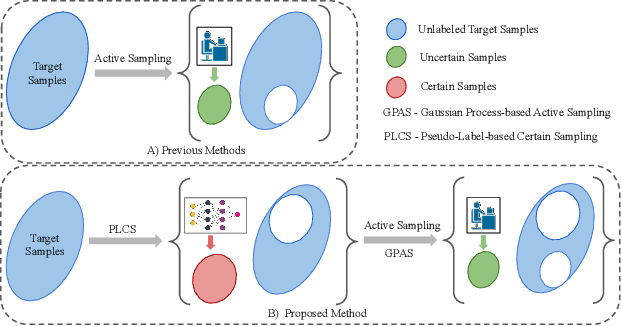

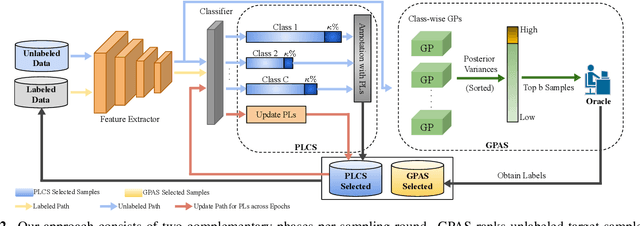

Abstract:Active Domain Adaptation (ADA) adapts models to target domains by selectively labeling a few target samples. Existing ADA methods prioritize uncertain samples but overlook confident ones, which often match ground-truth. We find that incorporating confident predictions into the labeled set before active sampling reduces the search space and improves adaptation. To address this, we propose a collaborative framework that labels uncertain samples while treating highly confident predictions as ground truth. Our method combines Gaussian Process-based Active Sampling (GPAS) for identifying uncertain samples and Pseudo-Label-based Certain Sampling (PLCS) for confident ones, progressively enhancing adaptation. PLCS refines the search space, and GPAS reduces the domain gap, boosting the proportion of confident samples. Extensive experiments on Office-Home and DomainNet show that our approach outperforms state-of-the-art ADA methods.
Filter Images First, Generate Instructions Later: Pre-Instruction Data Selection for Visual Instruction Tuning
Mar 10, 2025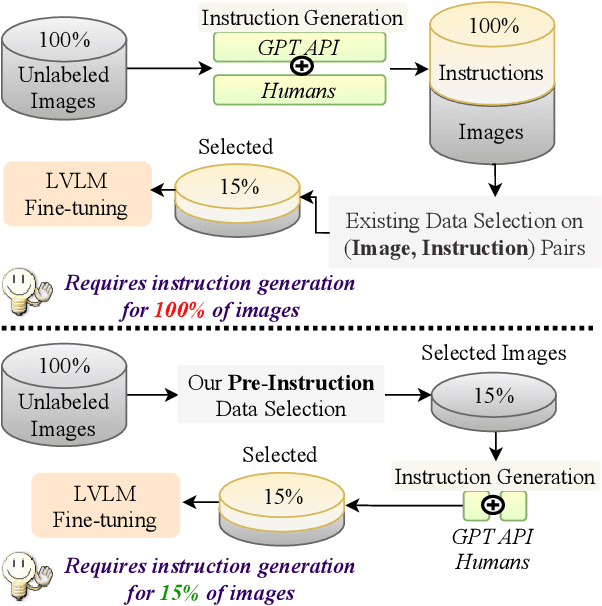

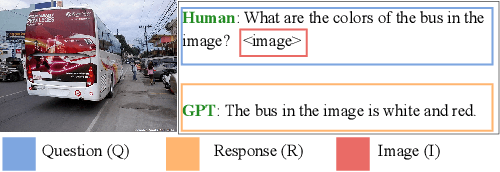

Abstract:Visual instruction tuning (VIT) for large vision-language models (LVLMs) requires training on expansive datasets of image-instruction pairs, which can be costly. Recent efforts in VIT data selection aim to select a small subset of high-quality image-instruction pairs, reducing VIT runtime while maintaining performance comparable to full-scale training. However, a major challenge often overlooked is that generating instructions from unlabeled images for VIT is highly expensive. Most existing VIT datasets rely heavily on human annotations or paid services like the GPT API, which limits users with constrained resources from creating VIT datasets for custom applications. To address this, we introduce Pre-Instruction Data Selection (PreSel), a more practical data selection paradigm that directly selects the most beneficial unlabeled images and generates instructions only for the selected images. PreSel first estimates the relative importance of each vision task within VIT datasets to derive task-wise sampling budgets. It then clusters image features within each task, selecting the most representative images with the budget. This approach reduces computational overhead for both instruction generation during VIT data formation and LVLM fine-tuning. By generating instructions for only 15% of the images, PreSel achieves performance comparable to full-data VIT on the LLaVA-1.5 and Vision-Flan datasets. The link to our project page: https://bardisafa.github.io/PreSel
Towards Zero-Shot Anomaly Detection and Reasoning with Multimodal Large Language Models
Feb 11, 2025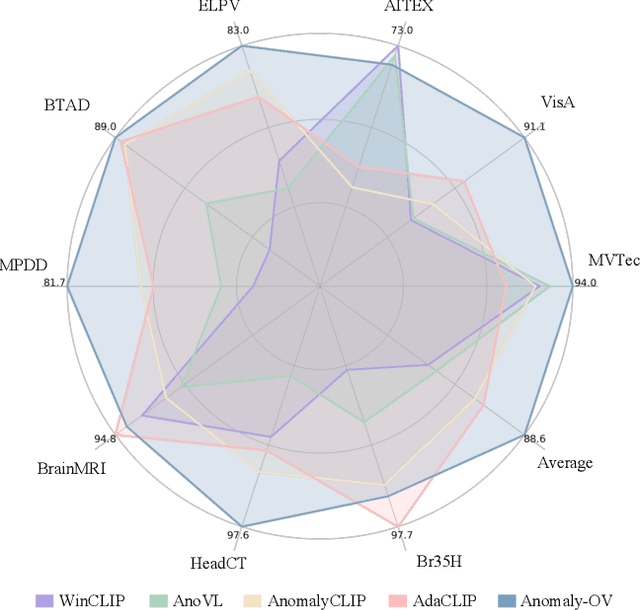
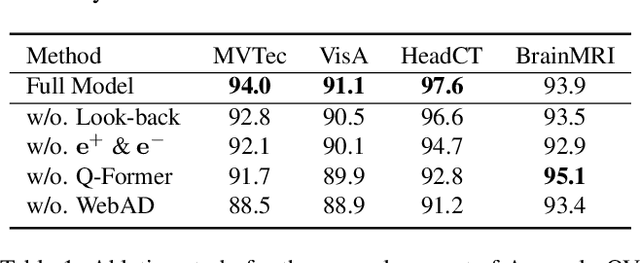
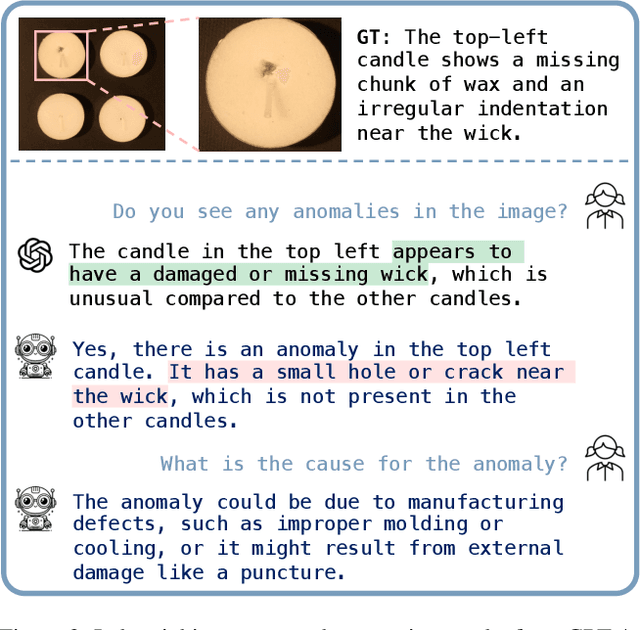

Abstract:Zero-Shot Anomaly Detection (ZSAD) is an emerging AD paradigm. Unlike the traditional unsupervised AD setting that requires a large number of normal samples to train a model, ZSAD is more practical for handling data-restricted real-world scenarios. Recently, Multimodal Large Language Models (MLLMs) have shown revolutionary reasoning capabilities in various vision tasks. However, the reasoning of image abnormalities remains underexplored due to the lack of corresponding datasets and benchmarks. To facilitate research in AD & reasoning, we establish the first visual instruction tuning dataset, Anomaly-Instruct-125k, and the evaluation benchmark, VisA-D&R. Through investigation with our benchmark, we reveal that current MLLMs like GPT-4o cannot accurately detect and describe fine-grained anomalous details in images. To address this, we propose Anomaly-OneVision (Anomaly-OV), the first specialist visual assistant for ZSAD and reasoning. Inspired by human behavior in visual inspection, Anomaly-OV leverages a Look-Twice Feature Matching (LTFM) mechanism to adaptively select and emphasize abnormal visual tokens. Extensive experiments demonstrate that Anomaly-OV achieves significant improvements over advanced generalist models in both detection and reasoning. Extensions to medical and 3D AD are provided for future study. The link to our project page: https://xujiacong.github.io/Anomaly-OV/
Active Learning for Vision-Language Models
Oct 29, 2024
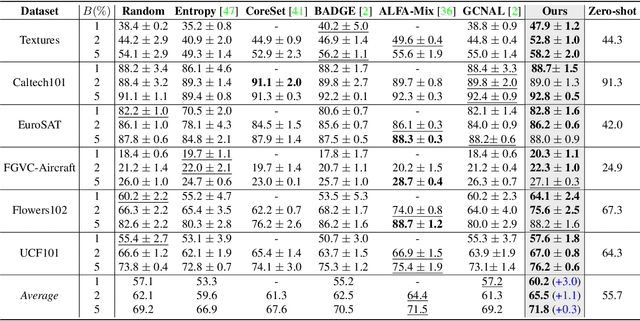
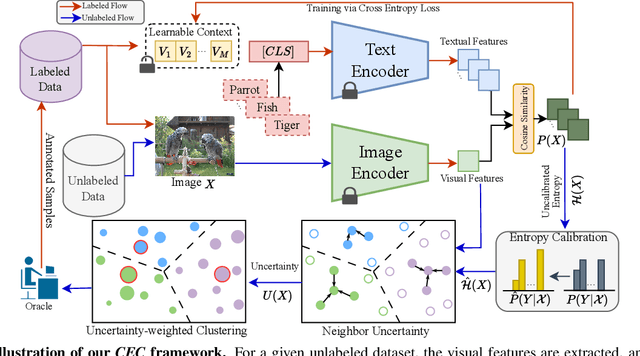
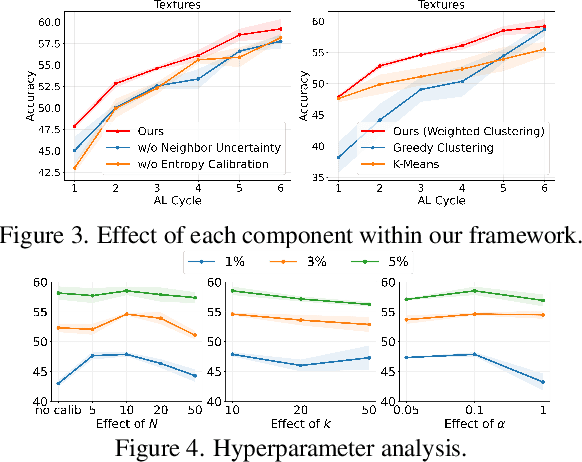
Abstract:Pre-trained vision-language models (VLMs) like CLIP have demonstrated impressive zero-shot performance on a wide range of downstream computer vision tasks. However, there still exists a considerable performance gap between these models and a supervised deep model trained on a downstream dataset. To bridge this gap, we propose a novel active learning (AL) framework that enhances the zero-shot classification performance of VLMs by selecting only a few informative samples from the unlabeled data for annotation during training. To achieve this, our approach first calibrates the predicted entropy of VLMs and then utilizes a combination of self-uncertainty and neighbor-aware uncertainty to calculate a reliable uncertainty measure for active sample selection. Our extensive experiments show that the proposed approach outperforms existing AL approaches on several image classification datasets, and significantly enhances the zero-shot performance of VLMs.
Gradient-Regularized Out-of-Distribution Detection
Apr 18, 2024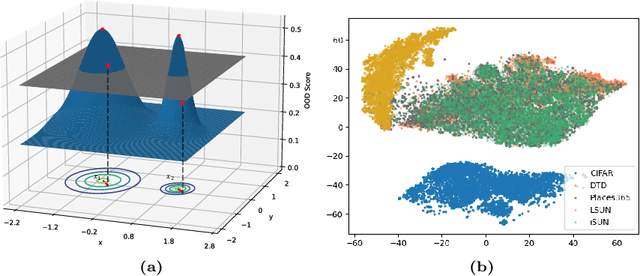

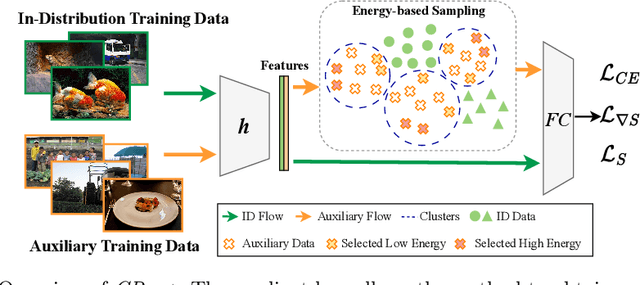
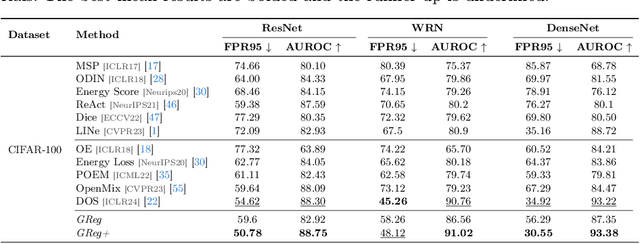
Abstract:One of the challenges for neural networks in real-life applications is the overconfident errors these models make when the data is not from the original training distribution. Addressing this issue is known as Out-of-Distribution (OOD) detection. Many state-of-the-art OOD methods employ an auxiliary dataset as a surrogate for OOD data during training to achieve improved performance. However, these methods fail to fully exploit the local information embedded in the auxiliary dataset. In this work, we propose the idea of leveraging the information embedded in the gradient of the loss function during training to enable the network to not only learn a desired OOD score for each sample but also to exhibit similar behavior in a local neighborhood around each sample. We also develop a novel energy-based sampling method to allow the network to be exposed to more informative OOD samples during the training phase. This is especially important when the auxiliary dataset is large. We demonstrate the effectiveness of our method through extensive experiments on several OOD benchmarks, improving the existing state-of-the-art FPR95 by 4% on our ImageNet experiment. We further provide a theoretical analysis through the lens of certified robustness and Lipschitz analysis to showcase the theoretical foundation of our work. We will publicly release our code after the review process.
Entropic Open-set Active Learning
Dec 21, 2023Abstract:Active Learning (AL) aims to enhance the performance of deep models by selecting the most informative samples for annotation from a pool of unlabeled data. Despite impressive performance in closed-set settings, most AL methods fail in real-world scenarios where the unlabeled data contains unknown categories. Recently, a few studies have attempted to tackle the AL problem for the open-set setting. However, these methods focus more on selecting known samples and do not efficiently utilize unknown samples obtained during AL rounds. In this work, we propose an Entropic Open-set AL (EOAL) framework which leverages both known and unknown distributions effectively to select informative samples during AL rounds. Specifically, our approach employs two different entropy scores. One measures the uncertainty of a sample with respect to the known-class distributions. The other measures the uncertainty of the sample with respect to the unknown-class distributions. By utilizing these two entropy scores we effectively separate the known and unknown samples from the unlabeled data resulting in better sampling. Through extensive experiments, we show that the proposed method outperforms existing state-of-the-art methods on CIFAR-10, CIFAR-100, and TinyImageNet datasets. Code is available at \url{https://github.com/bardisafa/EOAL}.
Open-Set Automatic Target Recognition
Nov 10, 2022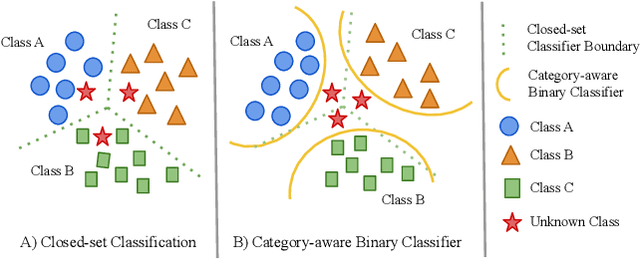

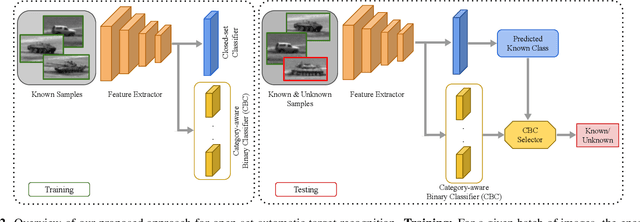

Abstract:Automatic Target Recognition (ATR) is a category of computer vision algorithms which attempts to recognize targets on data obtained from different sensors. ATR algorithms are extensively used in real-world scenarios such as military and surveillance applications. Existing ATR algorithms are developed for traditional closed-set methods where training and testing have the same class distribution. Thus, these algorithms have not been robust to unknown classes not seen during the training phase, limiting their utility in real-world applications. To this end, we propose an Open-set Automatic Target Recognition framework where we enable open-set recognition capability for ATR algorithms. In addition, we introduce a plugin Category-aware Binary Classifier (CBC) module to effectively tackle unknown classes seen during inference. The proposed CBC module can be easily integrated with any existing ATR algorithms and can be trained in an end-to-end manner. Experimental results show that the proposed approach outperforms many open-set methods on the DSIAC and CIFAR-10 datasets. To the best of our knowledge, this is the first work to address the open-set classification problem for ATR algorithms. Source code is available at: https://github.com/bardisafa/Open-set-ATR.
 Add to Chrome
Add to Chrome Add to Firefox
Add to Firefox Add to Edge
Add to Edge